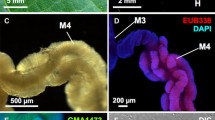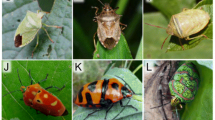Abstract
The southern green stinkbug Nezara viridula (Linnaeus) has a number of sac-like outgrowths, called crypts, in a posterior section of the midgut, wherein a specific bacterial symbiont is harbored. In previous studies on N. viridula from Hawaiian populations, experimental elimination of the symbiont caused few fitness defects in the host insect. Here we report that N. viridula from Japanese populations consistently harbors the same gammaproteobacterial gut symbiont, but, in contrast with previous work, experimental sterilization of the symbiont resulted in severe nymphal mortality, indicating an obligate host–symbiont relationship. Considering worldwide host–symbiont association and these experimental data, we suggest that N. viridula is generally and obligatorily associated with the gut symbiont, but that the effect of the symbiont on host biology may be different among geographic populations. Possible environmental factors that may affect the host–symbiont relationship are discussed.



Similar content being viewed by others
References
Abe Y, Mishiro K, Takanashi M (1995) Symbiont of brown-winged green bug, Plautia stali Scott. Jpn J Appl Entomol Zool 39:109–115
Buchner P (1965) Endosymbiosis of animals with plant microorganisms. Interscience, New York
Folmer O, Black M, Hoeh W, Lutz R, Vrijenhoek R (1994) DNA primers for amplification of mitochondrial cytochrome c oxidase subunit I from diverse metazoan invertebrates. Mol Marine Biol Biotechnol 3:294–299
Fukatsu T, Hosokawa T (2002) Capsule-transmitted gut symbiotic bacterium of the Japanese common plataspid stinkbug, Megacopta punctatissima. Appl Environ Microbiol 68:389–396
Fukatsu T, Nikoh N (1998) Two intracellular symbiotic bacteria from the mulberry psyllid Anomoneura mori (Insecta, Homoptera). Appl Environ Microbiol 64:3599–3606
Glasgow H (1914) The gastric caeca and the caecal bacteria of the Heteroptera. Biol Bull 3:101–171
Guindon S, Dufayard JF, Lefort V, Anisimova M, Hordijk W, Gascuel O (2010) New algorithms and methods to estimate maximum-likelihood phylogenies: assessing the performance of PhyML 3.0. Syst Biol 59:307–321
Hirose E, Panizzi AR, De Souza JT, Cattelan AJ, Aldrich JR (2006) Bacteria in the gut of southern green stink bug (Heteroptera: Pentatomidae). Ann Entomol Soc Am 99:91–95
Hosokawa T, Kikuchi Y, Nikoh N, Shimada M, Fukatsu T (2006) Strict host–symbiont cospeciation and reductive genome evolution in insect gut bacteria. PLoS Biol 4:e337
Kikuchi Y (2009) Endosymbiotic bacteria in insects: their diversity and culturability. Microbes Environ 24:195–204
Kikuchi Y, Hosokawa T, Fukatsu T (2007) Insect-microbe mutualism without vertical transmission: a stinkbug acquires beneficial gut symbiont from environment every generation. Appl Environ Microbiol 73:4308–4316
Kikuchi Y, Hosokawa T, Nikoh N, Meng XY, Kamagata Y, Fukatsu T (2009) Host–symbiont co-speciation and reductive genome evolution in gut symbiotic bacteria of acanthosomatid stinkbugs. BMC Biol 7:2
Kiritani K (2011) Impacts of global warming on Nezara viridula and its native congeneric species. J Asia Pac Entomol 14:221–226
Musolin DL (2007) Insects in a warmer world: ecological, physiological and life-history responses of true bugs (Heteroptera) to climate change. Glob Change Biol 13:1565–1585
Prado SS, Almeida RP (2009) Phylogenetic placement of pentatomid stink bug gut symbionts. Curr Microbiol 58:64–69
Prado SS, Rubinoff D, Almeida RPP (2006) Vertical transmission of a pentatomid caeca-associated symbiont. Ann Entomol Soc Am 99:577–585
Prado SS, Golden M, Follett PA, Daugherty MP, Almeida RP (2009) Demography of gut symbiotic and aposymbiotic Nezara viridula L. (Hemiptera: Pentatomidae). Environ Entomol 38:103–109
R Development Core Team (2010) R: A language and environment for statistical computing. R Foundation for Statistical Computing, Vienna, Austria. ISBN 3-900051-07-0, URL http://www.R-project.org
Schaefer CW, Panizzi AR (2000) Heteroptera of economic importance. CRC Press, Florida
Swofford DL (2001) PAUP* version 4.0b10 [computer program]. Sinauer, Sunderland
Thompson JD, Higgins DG, Gibson TJ (1994) CLUSTAL W: improving the sensitivity of progressive multiple sequence alignment through sequence weighting, position-specific gap penalties and weight matrix choice. Nucleic Acids Res 22:4673–4680
Todd JW (1989) Ecology and behavior of Nezara viridula. Annu Rev Entomol 34:273–292
Tougou D, Musolin DL, Fujisaki K (2009) Some like it hot! Rapid climate change promotes changes in distribution ranges of Nezara viridula and Nezara antennata in Japan. Entomol Exp Appl 130:249–258
Weirauch C, Schuh RT (2011) Systematics and evolution of Heteroptera: 25 years of progress. Annu Rev Entomol 56:487–510
Yukawa J, Kiritani K, Kawasawa T, Higashiura Y, Sawamura N, Nakada K, Gyotoku N, Tanaka A, Kamitani S, Matsuo K, Yamauchi S, Takematsu Y (2009) Northward range expansion by Nezara viridula (Hemiptera: Pentatomidae) in Shikoku and Chugoku Districts, Japan, possibly due to global warming. Appl Entomol Zool 44:429–437
Acknowledgments
We thank M. Baba and Y. G. Baba for insect samples. This study was supported by the Program for Promotion of Basic and Applied Research for Innovations in Bio-oriented Industry (BRAIN), the Japan Society for the Promotion of Science (JSPS), and The Council for Grants of the President of the Russian Federation and State Support of the Leading Scientific Schools (project # 3332.2010.4).
Author information
Authors and Affiliations
Corresponding author
Rights and permissions
About this article
Cite this article
Tada, A., Kikuchi, Y., Hosokawa, T. et al. Obligate association with gut bacterial symbiont in Japanese populations of the southern green stinkbug Nezara viridula (Heteroptera: Pentatomidae). Appl Entomol Zool 46, 483–488 (2011). https://doi.org/10.1007/s13355-011-0066-6
Received:
Accepted:
Published:
Issue Date:
DOI: https://doi.org/10.1007/s13355-011-0066-6




